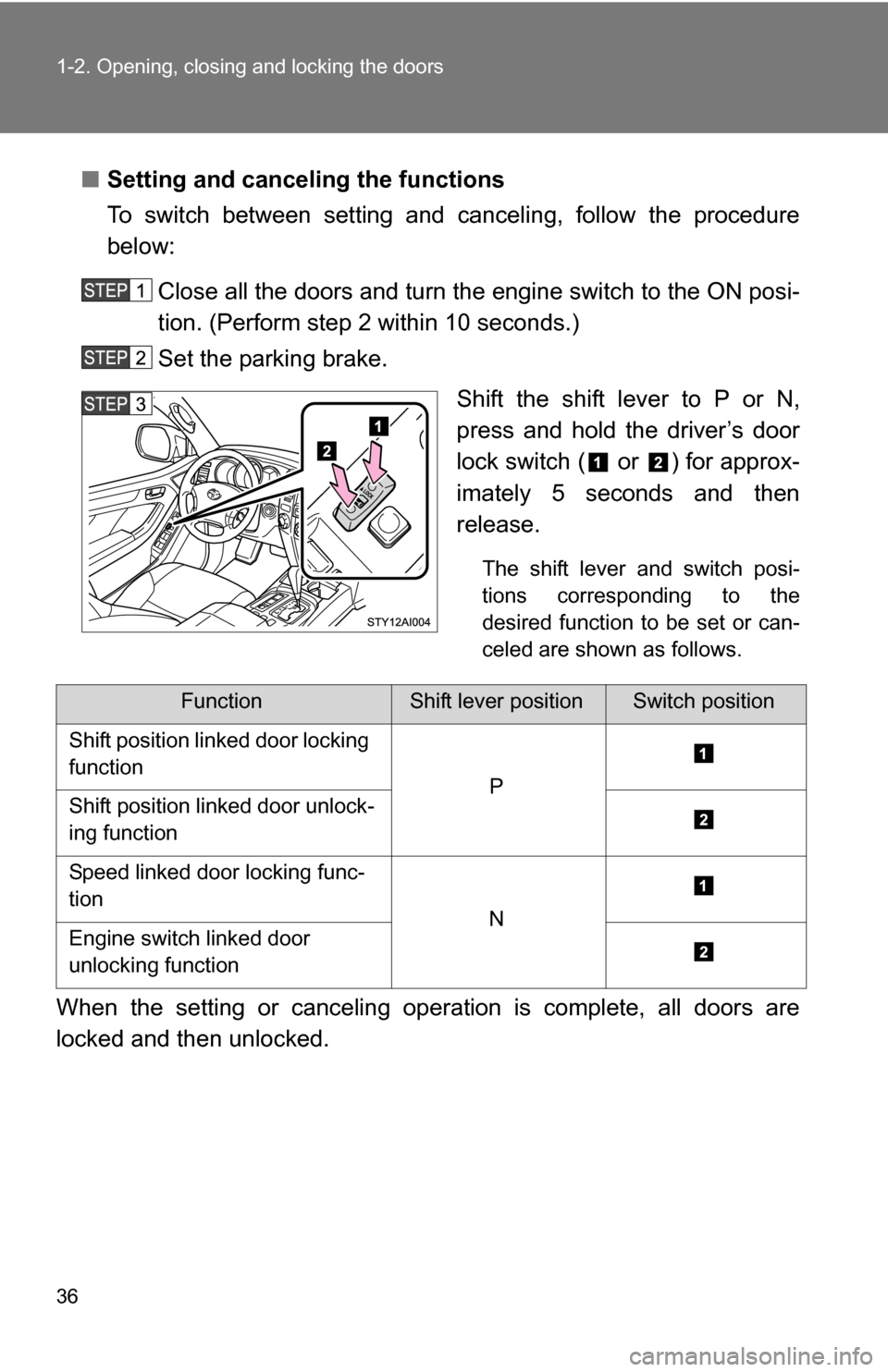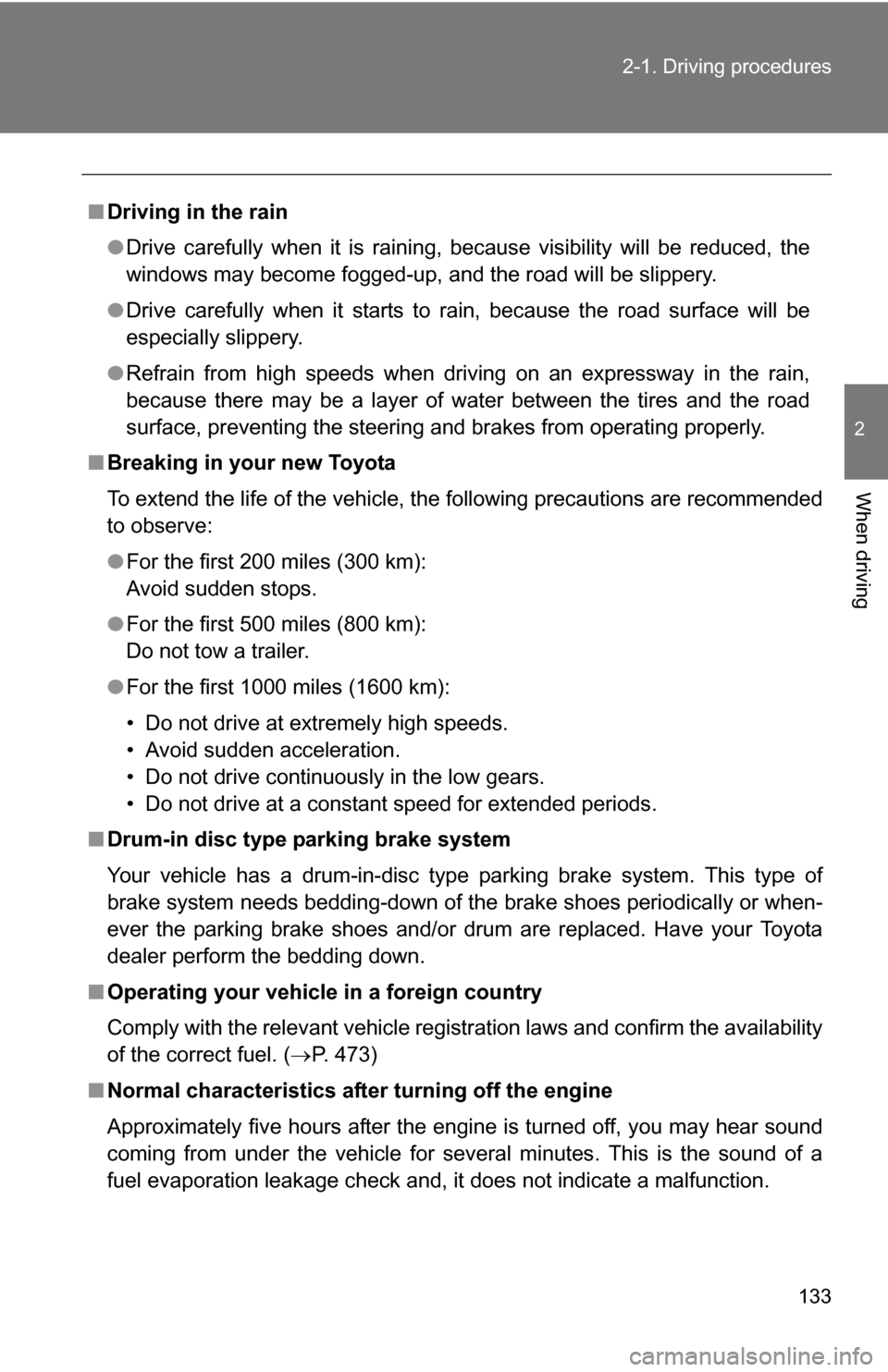2009 TOYOTA 4RUNNER parking brake
[x] Cancel search: parking brakePage 2 of 520

TABLE OF CONTENTSIndex
2
1-1. Key informationKeys ..................................... 28
1-2. Opening, closing and locking
the doors
Wireless remote control ....... 29
Side doors ............................ 33
Back door ............................. 38
1-3. Adjustable components
(seats, mirrors, steering
wheel)
Front seats ........................... 41
Rear seats ............................ 44
Driving position memory system ................................ 58
Head restraints ..................... 60
Seat belts ............................. 63
Steering wheel ..................... 69
Anti-glare inside rear view mirror .................................. 70
Outside rear view mirrors ..... 73
1-4. Opening a nd closing the
windo ws and moon roof
Power windows .................... 76
Power back window ............. 79
Moon roof ............................. 82
1-5. Refueling Opening the fuel tank cap .... 85 1-6. Theft deterrent system
Engine immobilizer system ... 88
Alarm .................................... 90
Theft prevention labels (U.S.A.)............................... 92
1-7. Safety information Correct driving posture ......... 93
SRS airbags ......................... 95
Front passenger occupant classification system
............ 108
Child restraint systems ....... 113
Installing child restraints ..... 117
2-1. Driving procedures Driving the vehicle .............. 132
Engine (ignition) switch....... 140
Automatic
Transmission...... 143
Turn signal lever ................. 145
Parking brake ..................... 146
Horn .................................... 147
2-2. Instrument cluster Gauges and meters ............ 148
Indicators and warning lights ................................. 151
Accessory meter ................. 155
2-3. Operating the li ghts and
wipers
Headlight switch ................. 158
Fog light switch ................... 162
Windshield wipers and washer .............................. 163
1Before driving
2When driving
Page 14 of 520

14
Pictorial indexInstrument panel
Headlight switch P. 158
Windshield wipers and
washer switch
P. 163
Fuel filler door opener P. 85
Gauges and meters P. 148
Hood lock release lever P. 372
Rear window wiper and
washer switch
P. 165
Turn signal lever P. 145
Fog light switch P. 162
Auxiliary box P. 322
Parking brake pedal P. 146
Page 36 of 520

36 1-2. Opening, closing and locking the doors
■Setting and canceling the functions
To switch between setting and canceling, follow the procedure
below:
Close all the doors and turn the engine switch to the ON posi-
tion. (Perform step 2 within 10 seconds.)
Set the parking brake. Shift the shift lever to P or N,
press and hold the driver’s door
lock switch ( or ) for approx-
imately 5 seconds and then
release.
The shift lever and switch posi-
tions corresponding to the
desired function to be set or can-
celed are shown as follows.
When the setting or canceling operation is complete, all doors are
locked and then unlocked.
FunctionShift lever positionSwitch position
Shift position linked door locking
function
PShift position linked door unlock-
ing function
Speed linked door locking func-
tion
NEngine switch linked door
unlocking function
Page 131 of 520

When driving2
131
2-1. Driving proceduresDriving the vehicle............ 132
Engine (ignition) switch .... 140
Automatic
Transmission.... 143
Turn signal lever .............. 145
Parking brake ................... 146
Horn ................................. 147
2-2. Instrument cluster Gauges and meters ......... 148
Indicators and warning lights .............................. 151
Accessory meter .............. 155
2-3. Operating the lights and wipers
Headlight switch ............... 158
Fog light switch ................ 162
Windshield wipers and washer ........................... 163
Rear window wiper and washer ........................... 165 2-4. Using other driving systems
Cruise control ................... 166
Electronically modulated air suspension ................ 169
AUTO LSD system (2WD models and
Multi-mode 4WD
models) .......................... 175
Four-wheel drive system (4WD models) ................ 177
Active traction control system (L4 mode on
4WD models) ................. 182
Rear differential lock system ........................... 184
Downhill Assist Control .... 186
Driving assist systems ..... 188
2-5. Driving information Off-road precautions ........ 198
Cargo and luggage .......... 203
Vehicle load limits ............ 211
Winter driving tips ............ 213
Trailer towing ................... 216
Dinghy towing .................. 228
Page 132 of 520

132
2-1. Driving procedures
Driving the vehicle
Starting on a steep uphillWith the brake pedal depressed, firmly set the parking brake
and shift the shift lever to D.
Gently depress the accelerator pedal.
Release the parking brake.
The following procedures should be observed to ensure safe driv-
ing.
■ Starting the engine ( P. 140)
■ Driving
With the brake pedal depressed, shift the shift lever to D. ( P. 143)
Release the parking brake. ( P. 146)
Gradually release the brake pedal and gently depress the
accelerator pedal to accelerate the vehicle.
■ Stopping
With the shift lever in D, depress the brake pedal.
If necessary, set the parking brake.
When the vehicle is stopped for an extended period of time, shift
the shift lever to P or N. (
P. 1 4 3)
■Parking the vehicle
With the shift lever in D, depress the brake pedal.
Set the parking brake. ( P. 146)
Shift the shift lever to P. ( P. 143)
When parking on a hill, if necessary, block the wheels.
Turn the engine switch off to stop the engine.
Lock the door, making sure that you have the key on your
person.
Page 133 of 520

133
2-1. Driving procedures
2
When driving
■
Driving in the rain
●Drive carefully when it is raining, because visibility will be reduced, the
windows may become fogged-up, and the road will be slippery.
● Drive carefully when it starts to rain, because the road surface will be
especially slippery.
● Refrain from high speeds when driving on an expressway in the rain,
because there may be a layer of water between the tires and the road
surface, preventing the steering and brakes from operating properly.
■ Breaking in your new Toyota
To extend the life of the vehicle, the following precautions are recommended
to observe:
●For the first 200 miles (300 km):
Avoid sudden stops.
● For the first 500 miles (800 km):
Do not tow a trailer.
● For the first 1000 miles (1600 km):
• Do not drive at extremely high speeds.
• Avoid sudden acceleration.
• Do not drive continuously in the low gears.
• Do not drive at a constant speed for extended periods.
■ Drum-in disc type parking brake system
Your vehicle has a drum-in-disc type parking brake system. This type of
brake system needs bedding-down of the brake shoes periodically or when-
ever the parking brake shoes and/or drum are replaced. Have your Toyota
dealer perform the bedding down.
■ Operating your vehicle in a foreign country
Comply with the relevant vehicle registration laws and confirm the availability
of the correct fuel. ( P. 473)
■ Normal characteristics afte r turning off the engine
Approximately five hours after the engine is turned off, you may hear sound
coming from under the vehicle for several minutes. This is the sound of a
fuel evaporation leakage check and, it does not indicate a malfunction.
Page 135 of 520

135
2-1. Driving procedures
2
When driving
CAUTION
■
When driving the vehicle
●Do not shift the shift lever to N while the vehicle is moving.
Doing so may cause the engine brake to not operate properly and lead to
an accident.
● Do not turn the engine off while driving.
The power steering and brake booster systems will not operate properly if
the engine is not running.
● Use engine braking (downshift) to maintain a safe speed when driving
down a steep hill.
Using the brakes continuously may cause the brakes to overheat and lose
effectiveness. ( P. 144)
● When stopped on an inclined surface, use the brake pedal and parking
brake to prevent the vehicle from rolling backward or forward and causing
an accident.
● Do not adjust the position of the steering wheel, the seat, or the inside or
outside rear view mirrors while driving.
Doing so may result in a loss of vehicle control that can cause accidents
that may result in death or serious injury.
● Always check that all passengers’ arms, heads or other parts of their bod-
ies are not outside the vehicle, as this may result in death or serious injury.
● Do not drive in excess of the speed limit. Even if the legal speed limit per-
mits it, do not drive over 85 mph (140 km/h) unless your vehicle has high-
speed capability tires. Driving over 85 mph (140 km/h) may result in tire
failure, loss of control and possible injury. Be sure to consult a tire dealer
to determine whether the tires on your vehicle are high-speed capability
tires or not before driving at such speeds.
■ When driving on slippery road surfaces
●Sudden braking, acceleration and steering may cause tire slippage and
reduce your ability to control the vehicle, resulting in an accident.
● Sudden changes in engine speed, such as engine braking caused by up-
shifting or down-shifting, may cause the vehicle to skid, resulting in an
accident.
Page 136 of 520

136 2-1. Driving procedures
CAUTION
■When driving on slippery road surfaces
●After driving through a puddle, lightly depress the brake pedal to make
sure that the brakes are functioning properly. Wet brake pads may prevent
the brakes from functioning properly. If the brakes on only one side are wet
and not functioning properly, steering control may be affected, resulting in
an accident.
■ When shifting the shift lever
Be careful not to shift the shift lever with the accelerator pedal depressed.
This may lead to unexpected rapid acceleration of the vehicle that may
cause an accident and result in death or serious injury.
■ When the vehicle is stopped
●Do not race the engine.
If the vehicle is in any gear other than P or N, the vehicle may accelerate
suddenly and unexpectedly, and may cause an accident.
● Do not leave the vehicle with the engine running for a long time.
If such a situation cannot be avoided, park the vehicle in an open space
and check that exhaust fumes do not enter the vehicle interior.
● Always keep a foot on the brake pedal while the engine is running to pre-
vent an accident caused by the vehicle moving.
■ When the vehicle is parked
●Do not leave glasses, cigarette lighters, spray cans, or soft drink cans in
the vehicle when it is in the sun.
Doing so may result in the following.
• Gas may leak from a cigarette lighter or spray can, and may lead to a
fire.
• The temperature inside the vehicle may cause the plastic lenses and plastic material of eye glasses to deform or crack.
• Soft drink cans may fracture, causing the contents to spray over the interior of the vehicle, and may also cause a short circuit in the vehi-
cle’s electrical components.
● Always apply the parking brake, shift the shift lever to P, stop the engine
and lock the vehicle.
Do not leave the vehicle unattended while the engine is running.